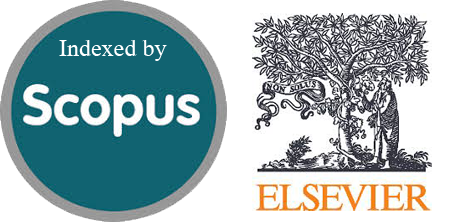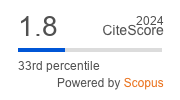Sentiment Analysis of Beauty Product E-Commerce Using Support Vector Machine Method
Abstract
Customers who buy goods will provide an assessment in the form of a review. If negative reviews dominate an item, other customers will be reluctant to buy at that store, so customers look for other stores, affecting the store's revenue. Therefore, this study aims to classify e-commerce beauty product reviews using the Support Vector Machine to create a model to categorize beauty product reviews and analyze accuracy. The research phase begins by collecting 50,000 datasets consisting of 35,000 training data and 15,000 test data. After the data is collected, the data labeling stage is carried out, labeled positive and negative. Then the preprocessing step is carried out so that the data is ready to be processed in the feature extraction step. The feature extraction step aims to explore potential information that represents words. Furthermore, the resulting data is evaluated to obtain an accuracy value and determine whether the model made is feasible to use. The results showed that the Support Vector Machine could classify beauty product reviews well with an accuracy of 80.06%.
Downloads
References
R. W. Primadineska, “Pengaruh Penggunaan Sistem Pembayaran Digital terhadap Perilaku Beralih di Era Pandemi COVID-19,” Telaah Bisnis, vol. 21, no. 2, p. 89, 2021, doi: 10.35917/tb.v21i2.215.
Undang-Undang Republik Indonesia, “Undang-Undang Republik Indonesia No. 7 Tahun 2014 Tentang Perdagangan,” LN.2014/No. 45, TLN No. 5512, LL SETNEG 56 HLM, pp. 1–56, 2014, [Online]. Available: https://peraturan.bpk.go.id/Home/Details/38584/uu-no-7-tahun-2014.
Putri, Cantika Adinda. 2021, November 18. Kuartal III-2021, Transaksi E-Commerce Turun Jauh ke Rp 58 T [Online]. Available: https://www.cnbcindonesia.com/tech/20211118173007-37-292654/kuartal-iii-2021-transaksi-e-commerce-turun-jauh-ke-rp-58-t.
S. N. Fauzi and L. Primasari, “Tindak Pidana Penipuan dalam Transaksi di Situs Jual Beli Online (E-Commerce),” Recidive, vol. 7, no. 3, pp. 250–261, 2018.
Izzudin. 2019, Februari 18. Fakta Menarik Amazon.com, Situs E-commerce Terbesar Di dunia [Online]. Available: https://kumparan.com/temali/fakta-menarik-amazon-com-situs-e-commerce-terbesar-dunia-1550208014712120226/full.
Autoridad Nacional del Servicio Civil, “済無No Title No Title No Title,” Angew. Chemie Int. Ed. 6(11), 951–952., pp. 2013–2015, 2021.
Nabila mecadinisa, “Melihat Perkembangan Industri Kosmetik di Indonesia Pasca Covid-19,” Fimela.Com. 2021, [Online]. Available: https://www.fimela.com/beauty/read/4578615/melihat-perkembangan-industri-kosmetik-di-indonesia-pasca-covid-19.
M. G. Pradana, “Penggunaan fitur wordcloud dan document term matrix dalam text mining,” J. Ilm. Inform., vol. 8, no. 1, pp. 38–43, 2020.
P. Arsi and R. Waluyo, “Analisis Sentimen Wacana Pemindahan Ibu Kota Indonesia Menggunakan Algoritma Support Vector Machine (SVM),” J. Teknol. Inf. dan Ilmu Komputer., vol. 8, no. 1, p. 147, 2021, doi: 10.25126/jtiik.0813944.
C. S. K. Aditya, M. Hani’ah, A. A. Fitrawan, A. Z. Arifin, and D. Purwitasari, “Deteksi Bot Spammer pada Twitter Berbasis Sentiment Analysis dan Time Interval Entropy,” J. Buana Inform., vol. 7, no. 3, pp. 179–186, 2016, doi: 10.24002/jbi.v7i3.656.
L. G. Irham, A. Adiwijaya, and U. N. Wisesty, “Klasifikasi Berita Bahasa Indonesia Menggunakan Mutual Information dan Support Vector Machine,” J. Media Inform. Budidarma, vol. 3, no. 4, p. 284, 2019, doi: 10.30865/mib.v3i4.1410.
N. Neneng, N. U. Putri, and E. R. Susanto, “Klasifikasi Jenis Kayu Menggunakan Support Vector Machine Berdasarkan Ciri Tekstur Local Binary Pattern,” Cybernetics, vol. 4, no. 02, pp. 93–100, 2021, doi: 10.29406/cbn.v4i02.2324.
A. Setiyono and H. F. Pardede, “Klasifikasi Sms Spam Menggunakan Support Vector Machine,” J. Pilar Nusa Mandiri, vol. 15, no. 2, pp. 275–280, 2019, doi: 10.33480/pilar.v15i2.693.
B. Das and S. Chakraborty, "An Improved Text Sentiment Classiciation Model Using TF-IDF and Next Word Negation"", 2018, arXiv preprint arXiv:1806.06407.
S. N. Alyami And S. O. Olantunji, "Application Of Support Vector Machine For Arabic Sentiment Classification Using Twitter-Based Dataset," J. Information & Knowledge Management, vol. 19, no. 01, 2020, 2040018.
G. Wang and S. Y. Shin, "An Improved Text Classification Method For Sentiment Classification," J. Information and Communication Convergence Engineering, vol. 17, no. 1, pp. 41-48, 2019.
H. N. Irmanda and Ria Astriratma, “Klasifikasi Jenis Pantun Dengan Metode Support Vector Machines (SVM),” J. RESTI (Rekayasa Sist. dan Teknol. Informasi), vol. 4, no. 5, pp. 915–922, 2020, doi: 10.29207/resti.v4i5.2313.
P. M. Prihatini, “Implementasi Ekstraksi Fitur Pada Pengolahan Dokumen Berbahasa Indonesia,” J. Matrix, vol. 6, no. 3, pp. 174–178, 2016.
M. Z. Naf’an, A. Burhanuddin, and A. Riyani, “Penerapan Cosine Similarity dan Pembobotan TF-IDF untuk Mendeteksi Kemiripan Dokumen,” J. Linguist. Komputasional, vol. 2, no. 1, pp. 23–27, 2019, doi: 10.26418/jlk.v2i1.17.
A. Suresh, “What is a confusion matrix?,” Medium. 2020, [Online]. Available: https://medium.com/analytics-vidhya/what-is-a-confusion-matrix-d1c0f8feda5.
Copyright (c) 2022 Jurnal RESTI (Rekayasa Sistem dan Teknologi Informasi)

This work is licensed under a Creative Commons Attribution 4.0 International License.
Copyright in each article belongs to the author
- The author acknowledges that the RESTI Journal (System Engineering and Information Technology) is the first publisher to publish with a license Creative Commons Attribution 4.0 International License.
- Authors can enter writing separately, arrange the non-exclusive distribution of manuscripts that have been published in this journal into other versions (eg sent to the author's institutional repository, publication in a book, etc.), by acknowledging that the manuscript has been published for the first time in the RESTI (Rekayasa Sistem dan Teknologi Informasi) journal ;








